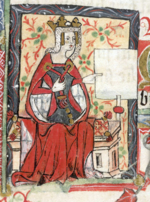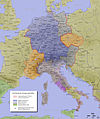- Overview
- Territories
- Featured Articles
- Good Articles
- Categories & lists
- Nobility project
- Holy Roman Empire task force
|
Welcome The purpose of the Holy Roman Empire portal is to make it easy for readers to find and explore articles about the Holy Roman Empire and its aristocratic families, as well as enabling editors to come together to work to enhance the subject and its themes. New editors are warmly welcome and invited to participate in adding new articles and improving existing ones – the first steps are very easy. Article of the month Article of the month
Empress Matilda  Empress Matilda (1102 – 1167) was the claimant to the English throne during the Anarchy. The daughter of Henry I of England, she moved to Germany as a child and married the future Holy Roman Emperor, Henry V. She travelled to Italy in 1116, was controversially crowned in St. Peter's Basilica, and acted as the imperial regent in Italy. Matilda and Henry had no children, and when he died in 1125, the crown was claimed by Lothair II. Meanwhile, Matilda's younger brother, William Adelin, died in 1120, leaving England facing a succession crisis. On Henry V's death, Matilda was recalled to Normandy by her father, who arranged for her to marry Geoffrey of Anjou to form an alliance to protect his southern borders. Henry I had no further children and nominated Matilda as his heir, but this was unpopular in the Anglo-Norman court. Henry died in 1135 but Matilda and Geoffrey were opposed by the Norman barons and unable to pursue their claims. The throne was taken by Stephen of Blois. In 1139, Matilda crossed to England to seize the kingdom, supported by Robert of Gloucester and her uncle, King David of Scotland, while Geoffrey conquered Normandy. Matilda's forces captured Stephen in 1141, but her attempt to be crowned at Westminster collapsed in the face of bitter opposition from the London crowds. As a result, Matilda was never formally declared Queen of England, but was instead titled Lady of the English. Robert was captured in 1141, and Matilda agreed to exchange him for Stephen. Matilda was trapped in Oxford Castle that winter, and had to escape at night to avoid capture. The war degenerated into a stalemate. Matilda returned to Normandy in 1148, leaving her eldest son to continue; he eventually succeeded as Henry II in 1154. She settled near Rouen and concerned herself with the administration of Normandy. She worked extensively with the Church, founding Cistercian monasteries, and was known for her piety. She was buried at Bec Abbey in 1167.
Quick start Important noble families Important imperial treaties, edicts and legal sources Conflicts and key events Terminology Organisation of the Empire Structures
Institutions of the Empire
|
Holy Roman Empire On 25 December 800, Pope Leo III crowned Frankish king Charlemagne as Roman emperor, reviving the title in Western Europe more than three centuries after the fall of the ancient Western Roman Empire in 476. The title lapsed in 924, but was revived in 962 when Otto I was crowned emperor by Pope John XII, fashioning himself as Charlemagne's and the Carolingian Empire's successor, and beginning a continuous existence of the empire for over eight centuries. From 962 until the 12th century, the empire was one of the most powerful monarchies in Europe. The functioning of government depended on the harmonious cooperation between emperor and vassals; this harmony was disturbed during the Salian period. The empire reached the apex of territorial expansion and power under the House of Hohenstaufen in the mid-13th century, but overextension of its power led to a partial collapse. Scholars generally describe an evolution of the institutions and principles constituting the empire, and a gradual development of the imperial role. While the office of emperor had been reestablished, the exact term for his realm as the "Holy Roman Empire" was not used until the 13th century, although the emperor's theoretical legitimacy from the beginning rested on the concept of translatio imperii, that he held supreme power inherited from the ancient emperors of Rome. Nevertheless, in the Holy Roman Empire, the imperial office was traditionally elective by the mostly German prince-electors. In theory and diplomacy, the emperors were considered the first among equals of all Europe's Catholic monarchs. A process of Imperial Reform in the late fifteenth and early sixteenth centuries transformed the empire, creating a set of institutions which endured until its final demise in the nineteenth century. According to historian Thomas Brady Jr., the empire after the Imperial Reform was a political body of remarkable longevity and stability, and "resembled in some respects the monarchical polities of Europe's western tier, and in others the loosely integrated, elective polities of East Central Europe." The new corporate German Nation, instead of simply obeying the emperor, negotiated with him. On 6 August 1806, Emperor Francis II abdicated and formally dissolved the empire following the creation – the month before, by French emperor Napoleon – of the Confederation of the Rhine, a confederation of German client states loyal not to the Holy Roman emperor but to France. (Full article...) History of the Holy Roman Empire  The Holy Roman Empire (Latin Sacrum Romanum Imperium) was the official name for the sovereign territory of the Roman-German Emperor from the Middle Ages to the year 1806. The name of the Empire is derived from the claim of its medieval rulers that it continued the tradition of the Ancient Roman Empire. The Holy Roman Empire is the forerunner of the modern nation-states of Germany and Austria. To distinguish it from the German Empire founded in 1871 it is also referred to by modern historians as the “Old Empire” (German: Altes Reich) more... Well known people of the Holy Roman Empire Emperors and kings Important church leaders Members • 01.02 Portal:Holy Roman Empire • • Archive Wanted articles |
Associated Wikimedia
![]() Photos
Photos ![]() Source texts
Source texts ![]() Citations
Citations ![]() Dictionary
Dictionary













